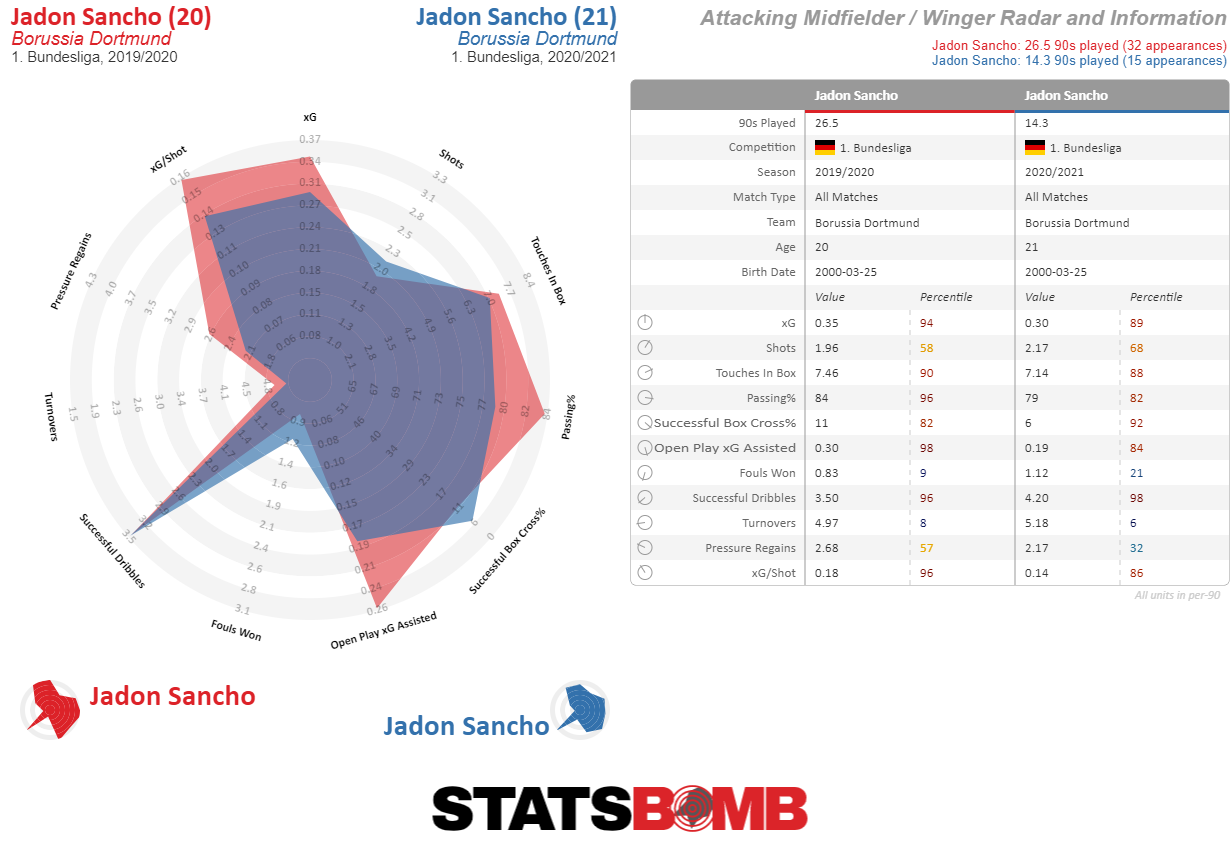Football is in gridlock at the moment. Still, rest assured the football industry doesn't simply stop existing. Instead, clubs are already planning ahead for the time after the current standstill. Borussia Dortmund might have to do tackle that time without Jadon Sancho. The young Englishman could go back to his mother country and leave a large gap that has to be filled.
What defines Sancho?
Generally, the attributes of the 20 year old are well known. He has developed into one of the most promising wingers in Europe in short time. Sancho disposes of the classic qualities of a dribbler on the flanks: He's able to move into one-on-one-duels diagonally from the sideline, sprint toward the goal line or create gaps on the perimeter of his field of vision by moving towards the inside. Sancho is agile and skilful on the ball.
Moreover, his is a very aggressive playing style. His risk-management is oriented in such a way that he'll accept loss of possession with a view to a potential gain in attacking output. That's why he gives away the ball quite frequently, but also why he's usually taking aim from a good position for scoring opportunities. Altogether, he shows a relatively large presence in the penalty area. He doesn't just move on the flanks around the box, rather orientating his game towards getting into the dangerous zones.
In that, Sancho doesn't resemble someone like Franck Ribéry, who developed his danger on the goal mainly from the wing, rather he moves into positions in the half-space. Generally, Sancho's game from the half-space is somewhat underappreciated. From there, he usually interacts with other attacking players of Dortmund's – such as Marco Reus or Julian Brandt. He frequently looks for a short pass to Reus or, as of late, Erling Håland, in order to immediately move into a position for a flick-on or a lay-off. He moves faster than his opponents, who have to lose sight of him for only a split-second to no longer be in a position to step in.
At BVB, Sancho functions so well also because he doesn't have to constantly run up and down the touchline. His work against the ball is rather sloppy and at times even clumsy. Longer runs without the option of getting to the middle diagonally are also not his strong suit. He's at his best in terms of sprinting when the team are running an open counter-attack. At Dortmund, Sancho is helped by the fact that he has flank-runners around him in Achraf Hakimi or Raphaël Guerreiro. Especially Hakimi, with his propensity to make runs behind the defensive line in the final third, fits well with Sancho's presence in the centre, since the focus will be on the Englishman, who can still serve up Hakimi through the gaps thanks to his agility.
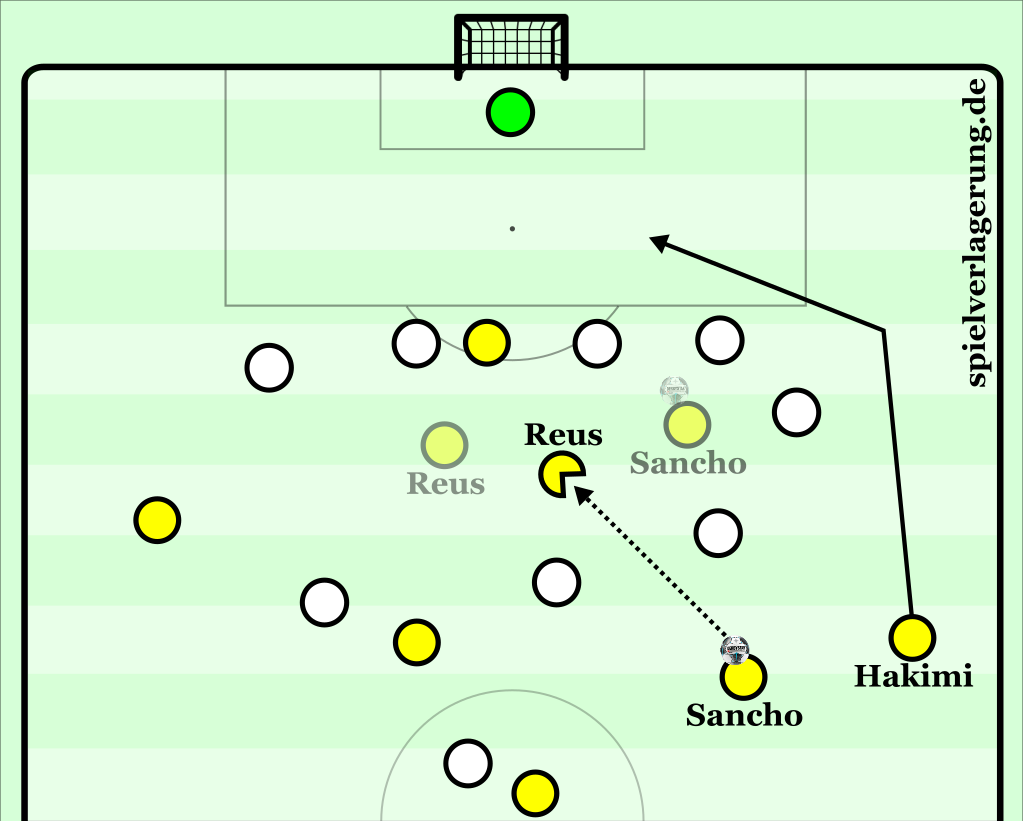
Typical situation: Sancho attacks a defending side, that is backtracking, through the half-space. He draws the attention of the two outside defenders on his right, allowing Hakimi to make a run behind the backline.
What does the Replacement Need to Bring to the Table?
Going by the attributes discussed above, BVB should not just look for a strong dribbler on the wings. There are a few of those in the Bundesliga and other parts of Europe. But, especially in a 3-4-3, BVB don't necessarily need someone for the three-man attacking line who mostly feels at home on the flank. That's what strong runners on the wing-back positions, such as Hakimi, Guerreiro and Nico Schulz are there for. The potential signing of Thomas Meunier further highlights how Dortmund will upgrade in that regard.
For this, we can use a "Similar Player Search" tool to analyse which Bundesliga players resemble Sancho during the current campaign. In that, we'll weight which values should factor into the comparison especially strongly and receive a number of interesting names in the category of players of up to 22 years of age who have played a minimum amount of 600 minutes – each with a percentage-wise correlation to Sancho. In declining order of correlation these are: Marcus Thuram, Christopher Nkunku, Kai Havertz, Dodi Lukebakio, Moussa Diaby, Josip Brekalo, Ruben Vargas, Amine Harit, Leon Bailey, Alphonso Davies, Marco Richter, Christoph Baumgartner, Rabbi Matondo, Javairô Dilrosun and Ismail Jakobs. Naturally, a number of candidates can be discarded for obvious reasons. Or does anyone think Davies will soon lace his boots for BVB? At the same time, we can highlight three interesting players.
Candidate 1: Moussa Diaby
I might have suggested Diaby as a fairly obvious option without looking at stats. The Bayer Leverkusen wingman is not yet as consistently successful in his actions as Sancho – particularly in the opponent's box – but he combines agility and skill on the ball with a clear push towards the goal. An added benefit is that he's not being used as a clear-cut winger in Peter Bosz's system, rather having the freedom or even task of positioning himself in the half-space or playing into these zones. Diaby doesn't just attack defensive lines from the flank, but also penetrates them in positional gaps. With that, he could fit into Lucien Favre's system well. There shouldn't be any doubts concerning his general footballing and athletic qualities at any rate.
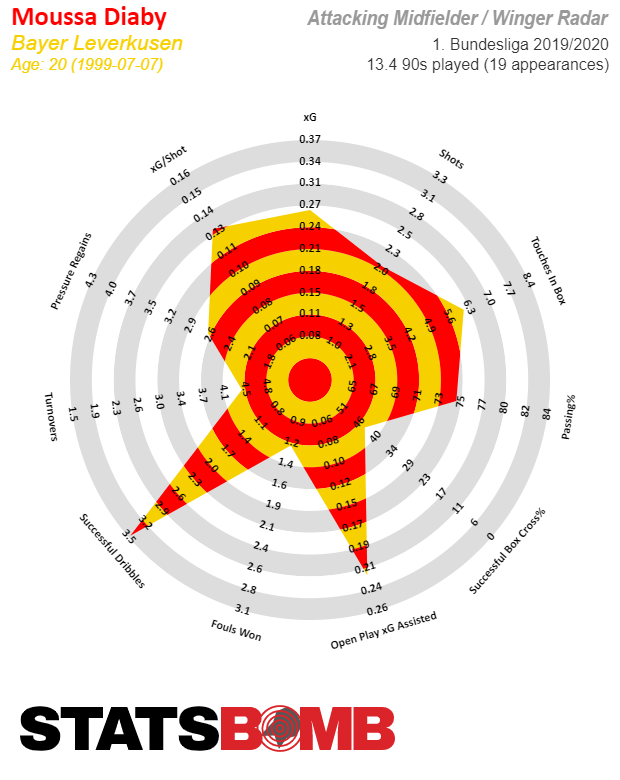
Candidate 2: Ruben Vargas
Vargas of FC Augsburg is harder to judge than Diaby seeing as he can profit from his team's playing style only to a limited extent at the moment. FCA is one of the Bundesliga teams with a small amount of attacking productivity in terms of shots on goal. Vargas can hardly change that situation by himself, but maybe he doesn't have to. For especially in the transitional game, he develops a respectable penetrating power in spite of it all, which is clear to see even in isolated situations. Because of that, the motto when talking about Vargas has to be: If someone can have so much attacking presence while playing in weaker surroundings, they surely must shine all the more with better teammates. The pitfall here is that there might be an error in reasoning. Because Vargas does also profit from Augsburg's transitional football, in that he has more freedoms and only rarely has to successfully convert detailed actions. Vargas is a candidate that makes it obvious how it's not so easy to judge a player's performances in relation to the quality of his team and in the context of a potentially different playing style in the future.
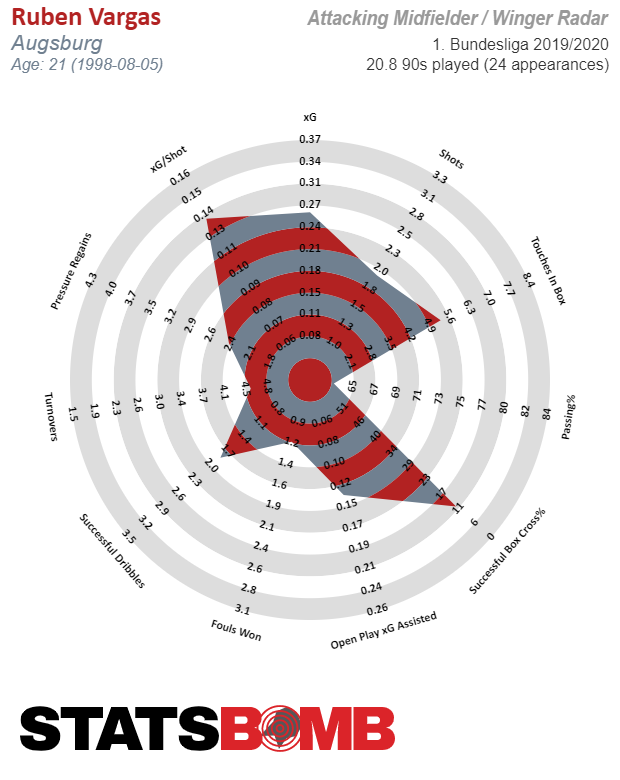
Candidate 3: Christoph Baumgartner
The mention of this 20-year-old TSG Hoffenheim player may come as somewhat of a surprise. Baumgartner is widely regarded as the biggest talent in the Bundesliga squad of the team from the Kraichgau in south-west Germany. However, he was handed round from position to position this season – very much in keeping with the style of head coach Alfred Schreuder. Between right-sided wing-back and left-sided supporting striker, he's played in almost every position already. Baumgartner, in any case, is a player who shines brightest as a No. 10 or as an attacking winger. His aggressive and at the same time agile playing style in the final third somewhat resembles Sancho's in some aspects. Of course, Baumgartner doesn't have that special something while dribbling whatsoever. Should Dortmund be looking for a young candidate, however, who can factor into the plans both as a disguised winger and a potential back-up for Reus, Baumgartner could become a possibility. Similarly to Sancho one and a half years ago, Baumgartner is still a bit inconsistent in his decision-making. Still, the appearances he's made in the Bundesliga have shown in time that he's developing rapidly.
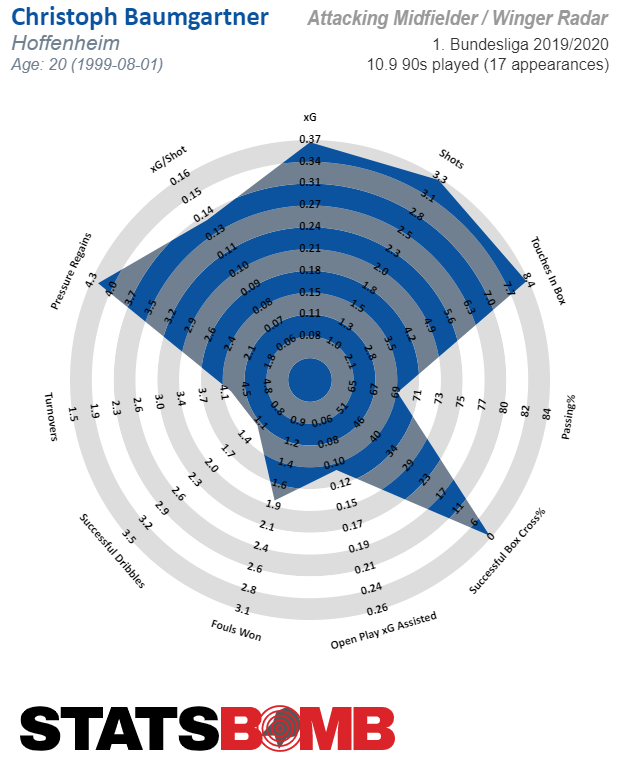
Whoever Dortmund sign after Sancho, it won't be an equivalent replacement from day one, but rather someone with the required potential to in his way shape BVB's attack in the short- and especially medium-term. That was already the case with Sancho. And that turned out to be a lucrative model for Dortmund both in sporting and monetary terms.
